Cross Sections of Noodles Observed at Various Cooling Temperatures
SM065
Comparison of cross sections of noodles at various temperatures
Dried noodles were boiled under the same conditions. These noodles were then cooled at various temperatures, listed on the table below, before they were cut or fractured. The prepared specimens were observed by SEM in low vacuum (LV) mode.
| Cooling temperature | (1) 4°C (in refrigerator) | (2) -20°C (in freezer) | (3) -79°C (with dry ice) | (4) -196°C (with liquid nitrogen) |
| Cross section preparation | Cross section fracture unit (CSC III) |
Cross section fracture unit (CSC III) |
Freeze fracture unit | Freeze fracture unit |
| Magnification x500 LV mode, uncoated LV cooling holder used |
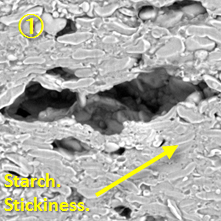 |
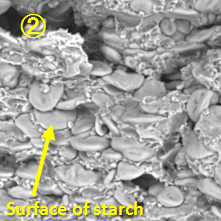 |
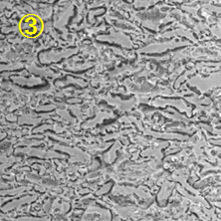 |
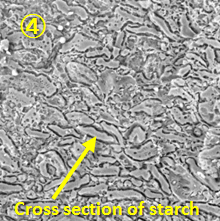 |
| Before observation | LV cooling holder was cooled in the refrigerator. | LV cooling holder was cooled in the freezer. | LV cooling holder was cooled with dry ice. | LV cooling holder was cooled with liquid nitrogen. |
| Status of cross section | Since the specimen was not frozen, a cut face was created by a razor blade. Due to the stickiness of the specimen, a clean cross section was not possible causing unclear boundaries between the starch and other parts. | Due to insufficient freezing of noodles, noodles were peeled away from the starch particles. The starch particle diameter was easy to measure. | Freeze fracturing was possible. Ice crystals around starch particles were confirmed before the increase of temperature. |
Freeze fracturing was possible. When the freezing with liquid nitrogen was made, starch particles embedded in the ice crystals were confirmed. |
| Remarks | At 4°C, vaporization of water from the specimen occurred during SEM observation, allowing confirmation of the compositional distribution in the specimen. Detailed information on ice crystals was unable to be obtained. | Even at -20°C, vaporization of water from the specimen occurred during SEM observation. The cross section was non-uniform due to the various particle sizes of the starch. | At dry ice temperatures, the time to reach sublimation was very short. Observation in a frozen state was very difficult. | Stable observation was enabled with liquid nitrogen cooling. |
| Result | Impossible to fracture. The specimen was dehydrated during observation. |
Impossible to freeze fracture. The specimen was dehydrated during observation. |
Possible to freeze fracture. Observation in a frozen state was difficult. Observation in a freeze dried state was possible. |
Possible to freeze-fracture. Observation in a frozen state was possible. |
Conclusion
Liquid nitrogen is essential for SEM observation in a frozen state.
Although the dry ice cooled specimen observation in a frozen state was difficult, necessary information can be obtained depending on some specimen type or observation purpose.
Comparison of SEM images of noodles in frozen state and freeze dried state, using dry ice
In SEM observation using an LV cooling holder, the specimen temperature gradually increases and sublimation takes place, so the specimen state is transformed to a freeze dried state during the observation. In this state, specimen deformation can arise. In particular, at cooling with dry ice, the time to reach sublimation is very short and therefore, the specimen is likely to be observed in a freeze dried state.
In the frozen state, starch particles, embedded in ice crystals, are observed. In the freeze dried state, ice crystals around the starch particles are sublimated, revealing the emergence of voids.
In the freeze dried state, it is possible to confirm the size of starch particles, but difficult to view the status of the ice crystals.
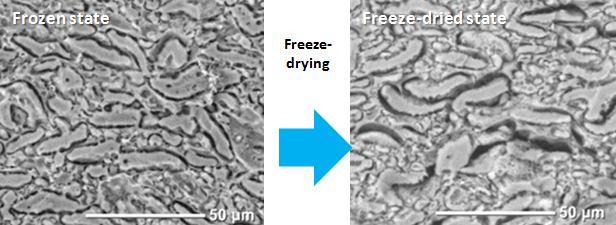
- Please see the PDF file for the additional information.
Another window opens when you click. 
PDF 893MB
Related Products
Are you a medical professional or personnel engaged in medical care?
No
Please be reminded that these pages are not intended to provide the general public with information about the products.
